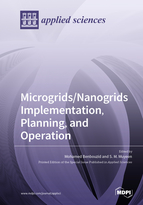Microgrids/Nanogrids Implementation, Planning, and Operation
A special issue of Applied Sciences (ISSN 2076-3417). This special issue belongs to the section "Electrical, Electronics and Communications Engineering".
Deadline for manuscript submissions: closed (15 June 2022) | Viewed by 20727
Special Issue Editors
Interests: fault detection and diagnosis; failure prognosis; cyberattack detection; fault-resilient control; machine learning
Special Issues, Collections and Topics in MDPI journals
Interests: renewable energy and smart grids
Special Issues, Collections and Topics in MDPI journals
Special Issue Information
Dear Colleagues,
Microgrids can allow a better integration of distributed energy storage capacity and renewable energy sources into the power grid, therefore increasing its efficiency and resilience to natural and man-caused disruptive events. In addition, microgrids and nanogrids are potential solutions for providing a better electrical service to both insufficiently supplied and remote areas. Microgrids networking with an optimal energy management will lead to a sort of smart grid with numerous benefits, such as reduced cost, and enhanced reliability and resiliency.
The objective of this Special Issue is to address and disseminate state-of the-art research and results on the implementation, planning, and operation of microgrids/nanogrids, for which energy management is one of the core issues. Topics of interest include, but are not limited to:
– Implementation of control and optimization techniques in grid-connected and islanded modes;
– Peer-to-peer energy management systems in community microgrid;
– Peer-to-peer energy trading in microgrids;
– Power grid resilience enhancement through microgrid facilities;
– Self-healing strategies for resilience purpose;
– Power quality assessment and improvement;
– Microgrids transformation into virtual power plants;
– Mobility-aware vehicle-to-grid control in microgrids
– Building an (nanogrid-) integrated energy management and monitoring system;
– Maritime applications: shipboard microgrids, offshore platforms, and port electrification;
– Aerospace applications: satellite microgrids, spacecraft power systems, and moon/mars station microgrids;
– Applied IoT architecture and communication technologies for smart microgrids;
– Smart enabling technologies for the effective penetration of microgrids.
Prof. Dr. Mohamed Benbouzid
Prof. S. M. Muyeen
Guest Editors
Manuscript Submission Information
Manuscripts should be submitted online at www.mdpi.com by registering and logging in to this website. Once you are registered, click here to go to the submission form. Manuscripts can be submitted until the deadline. All submissions that pass pre-check are peer-reviewed. Accepted papers will be published continuously in the journal (as soon as accepted) and will be listed together on the special issue website. Research articles, review articles as well as short communications are invited. For planned papers, a title and short abstract (about 100 words) can be sent to the Editorial Office for announcement on this website.
Submitted manuscripts should not have been published previously, nor be under consideration for publication elsewhere (except conference proceedings papers). All manuscripts are thoroughly refereed through a single-blind peer-review process. A guide for authors and other relevant information for submission of manuscripts is available on the Instructions for Authors page. Applied Sciences is an international peer-reviewed open access semimonthly journal published by MDPI.
Please visit the Instructions for Authors page before submitting a manuscript. The Article Processing Charge (APC) for publication in this open access journal is 2400 CHF (Swiss Francs). Submitted papers should be well formatted and use good English. Authors may use MDPI's English editing service prior to publication or during author revisions.







